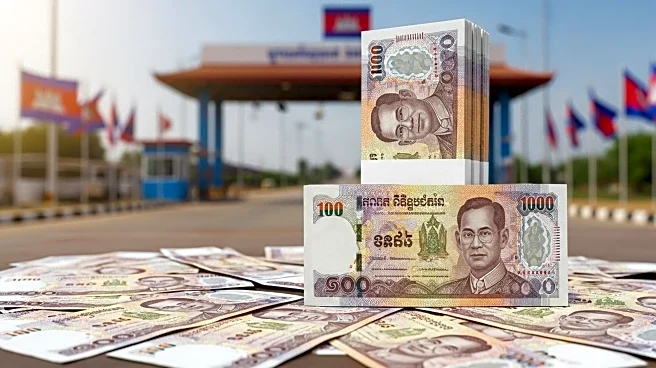What is the story about?
What's Happening?
The Cambodian riel is increasingly becoming the preferred currency at the Daung International Border Gate in Battambang province, as traders, service providers, and travelers opt for the local currency over the Thai baht. This shift has been accelerated by Thailand's unilateral closure of the gate in June, prompting local businesses to favor riel transactions. Restaurants, currency exchange booths, and transport services near the border have reported a surge in riel usage, with price tags and menus now predominantly displayed in riel. The transition is attributed to the simplicity and stability of using the riel, which eliminates the need for complex currency conversions. The National Bank of Cambodia has long promoted riel usage to enhance economic resilience and reduce reliance on foreign currencies.
Why It's Important?
The growing use of the Cambodian riel at the border signifies a strengthening of national currency confidence and economic independence. This trend supports Cambodia's monetary policy by reducing dependence on foreign currencies, particularly the Thai baht. The shift aligns with the National Bank of Cambodia's 'rielization' strategy, which aims to bolster the currency's role in pricing, payments, and savings. Wider riel usage enhances Cambodia's economic resilience, supporting domestic monetary policy and reducing exposure to foreign currency risks. Senate President Hun Sen has emphasized the importance of using the riel, framing it as a matter of national pride and sovereignty, and has called for stricter enforcement against illegal imports from Thailand.
What's Next?
As the riel continues to gain traction, authorities may increase efforts to promote its use further, potentially implementing policies to encourage riel transactions across more regions. The National Bank of Cambodia may intensify campaigns to educate the public on the benefits of using the riel, aiming to strengthen its role in the national economy. Additionally, businesses and money changers might be incentivized to offer competitive exchange rates and price goods in riel, contributing to a more unified domestic economy. The government may also focus on cracking down on smuggling and corruption to protect local industries and reinforce the riel's dominance.
Beyond the Headlines
The shift towards riel usage at the border could have long-term implications for Cambodia's economic sovereignty and stability. By reducing reliance on foreign currencies, Cambodia can better control its monetary policy and protect its economy from external shocks. This development may also foster a sense of national pride and unity, as citizens increasingly view the riel as a symbol of economic independence. The move could encourage other regions to adopt similar practices, further strengthening the riel's position as a primary medium for transactions and savings.
AI Generated Content
Do you find this article useful?

















